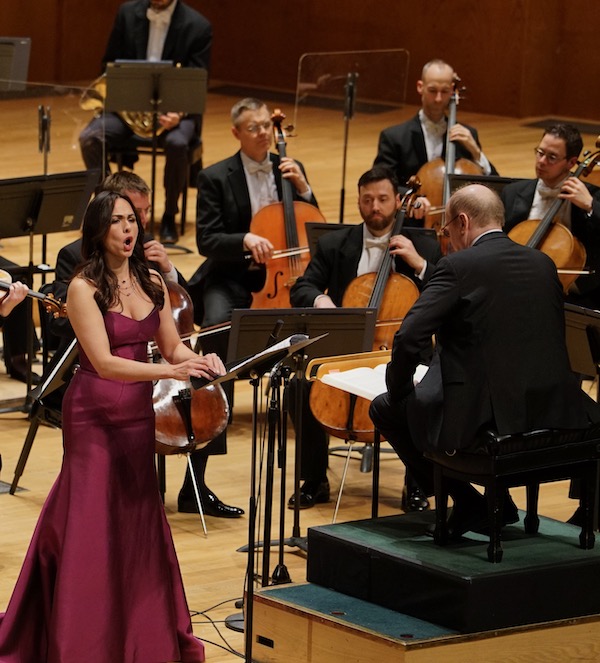Leonard and Labadie a good match for Mozart with Utah Symphony

The Utah Symphony doesn’t often engage opera singers as soloists for its concerts. So with the celebrated mezzo-soprano Isabel Leonard making an appearance, this week’s concerts in Abravanel Hall looked to provide a real treat.
An announcement was made before the concert that the 37-year-old singer was under the weather and would be shortening her program. Unfortunately, that meant that Mozart’s magnificent motet Exsultate, jubilate would be jettisoned.
What Leonard did sing were the three Mozart arias on the program: “Non so più” and “Voi che sapete” from The Marriage of Figaro and “Deh per questo istante” from La clemenza di Tito.
Leonard’s voice didn’t seem to suffer any discernible effects from her indisposition. Her rich, burnished voice was evident as was her delicately crafted expressiveness and florid lyricism. And she brought out her characters’ emotional state emphatically in each of the three arias.
The two numbers from The Marriage of Figaro are sung by the lovesick page Cherubino. Leonard underscored the teenager’s feelings of love and being in love with subtly delivered nuances that brought Cherubino to life.
And Leonard also did full justice to “Deh per questo istante,” sung by Sesto in Tito. She captured the mixed emotions Sesto feels by falling in love and scheming with Vitellia in an assassination plot against the title emperor.
Guest conductor Bernard Labadie, an excellent interpreter of 18th century music, provided sensitive and responsive accompaniment to Leonard’s vocal line in each aria.
In an unusual substitution for the scheduled Exsultate, jubilate, the Fremont Quartet performed Beethoven’s Quartet in G major, op. 18, no. 2.
While it’s decidedly unusual to have a string quartet take the stage in the middle of a symphony concert, the ad hoc swap worked quite well and balanced out the program, which also included Mendelssohn’s Symphony No. 4, “Italian.”
Formed in 2017 by the Utah Symphony’s first chair players (violinists Madeline Adkins and Claude Halter, violist Brant Bayless and cellist Matthew Johnson), the Fremont members gave a finely crafted reading of the quartet that emphasized the lighthearted spirit of the music. Only the second quartet Beethoven wrote, the work is strongly rooted in the late 18th century and clearly shows the influence of Haydn in its thematic makeup, harmonic language and structure.
Three of the four movements are light and airy and based on simple themes that Beethoven cleverly develops. The four captured the unassuming character of these movements by playing them with a lightness of touch that was nimble and filled with lyrical clarity. The Adagio offers contrast with darker expression and the quartet gave a nuanced and fluid expression to the music.
Also on the program were the overtures to The Marriage of Figaro and La clemenza di Tito. Labadie displayed a fine sense of tempo and definition in his readings. Both were clean and well-delineated, and the orchestra played with crisp articulation and well-crafted phrasing.
The concert closed with the Mendelssohn symphony.
Labadie’s tempo for the opening movement was brisk, underscoring the sunny disposition of the music. He allowed the orchestra to play full out, and while it wasn’t the most nuanced reading of this movement, it nevertheless captured the youthful vigor and vitality of the music.
The second movement was sprightly in its pace with strong, fluid lines, particularly in the upper strings. Here Labadie’s reading was more detailed than in the first movement and let the subtleties of the music unfold naturally. And although the minuet-like third movement was deliberately paced, Labadie’s interpretation still allowed the music to flow leisurely. The ensemble played with stately, well-defined phrases that brought out the lyricism of the music. The horn solos, played by Edmund Rollett and Stephen Proser, were beautifully crafted and expressed.
The saltarello finale returned to the unbridled joy of the opening movement. Labadie’s incessantly frenetic tempo brought out the exuberance and high spirits of the music while also delivering a surprisingly subtle and dynamically shaded reading.
The program will be repeated 7:30 p.m. Saturday in Abravanel Hall. utahsymphony.org; 801-355-2787.